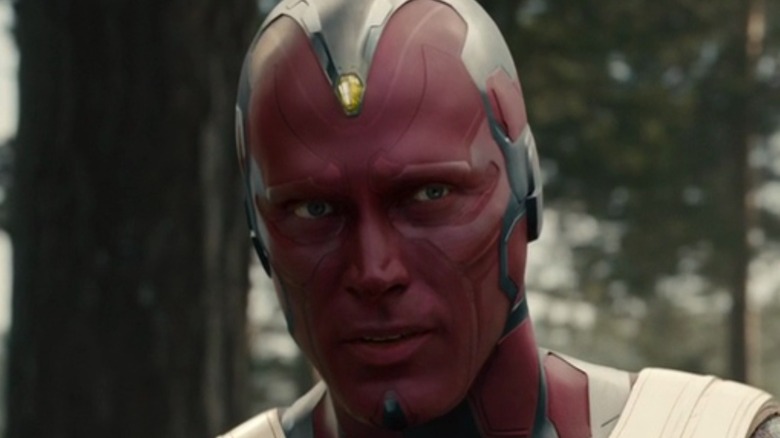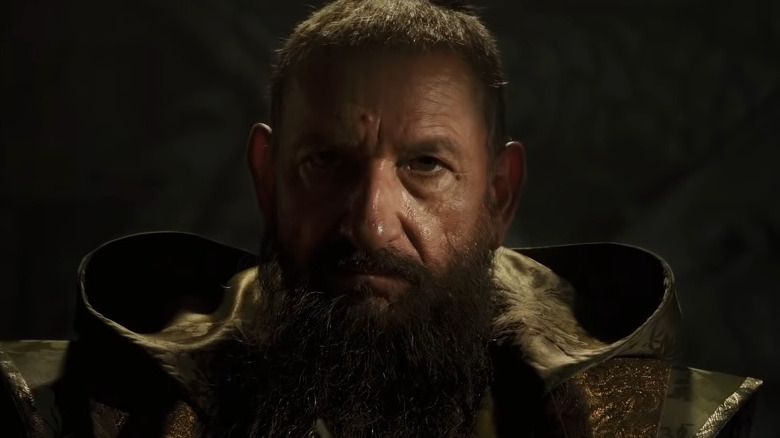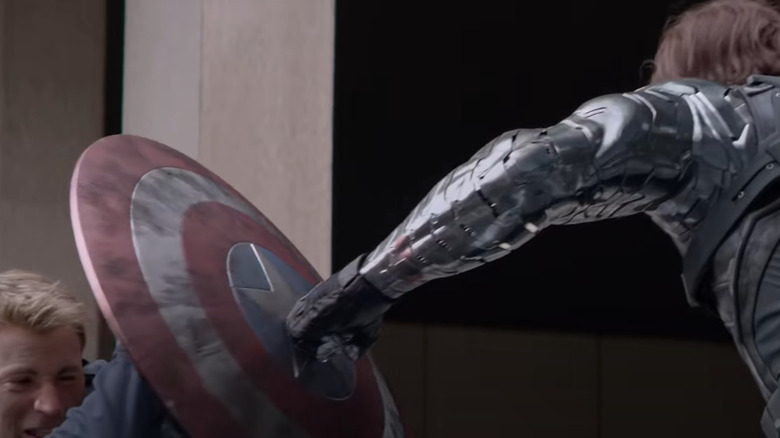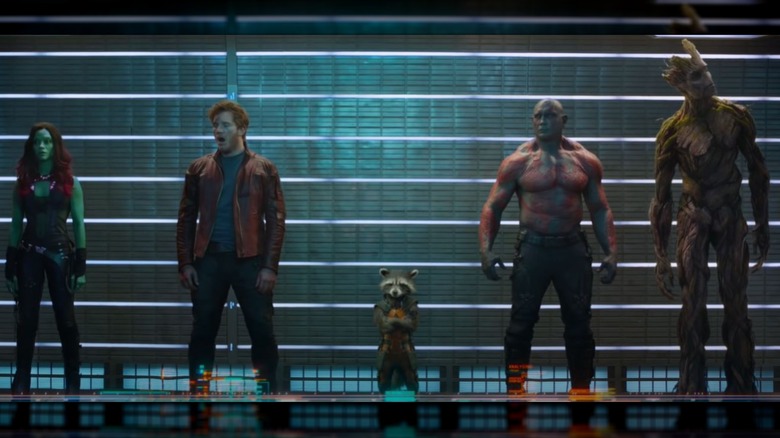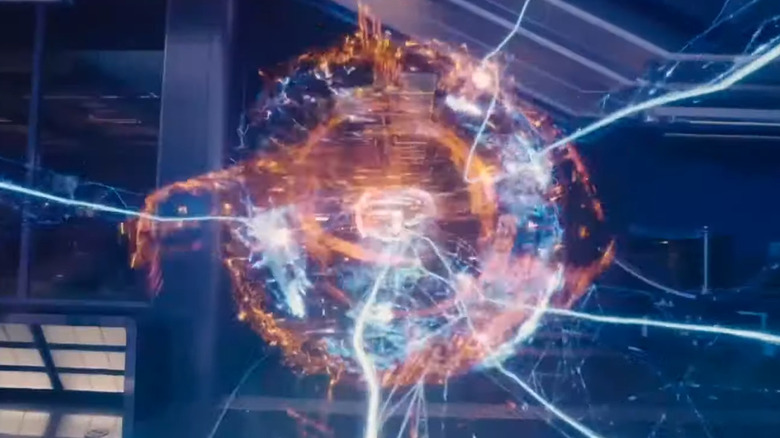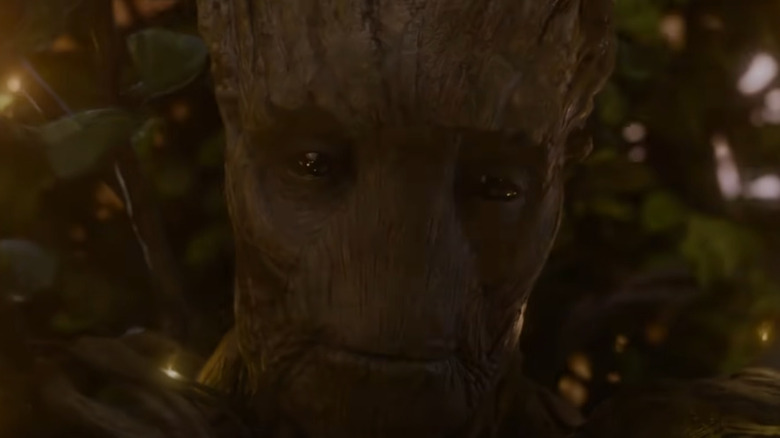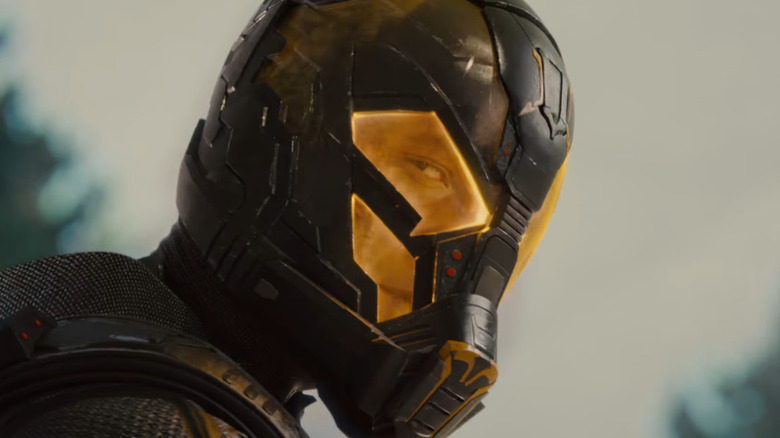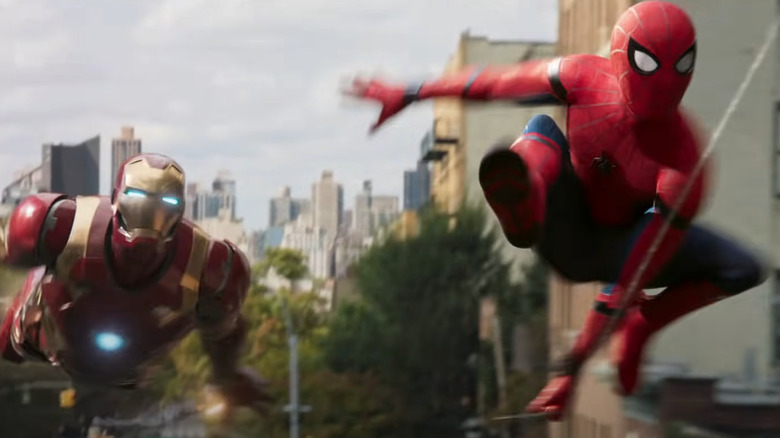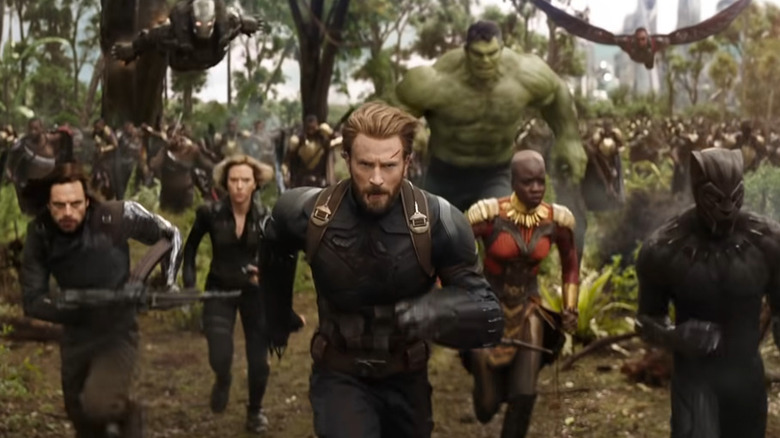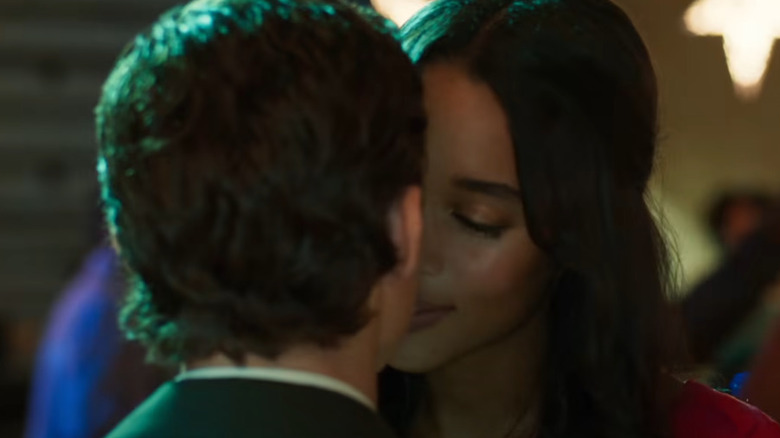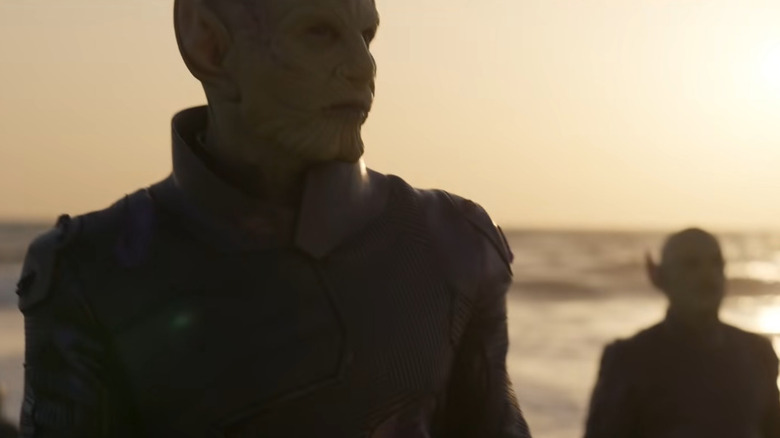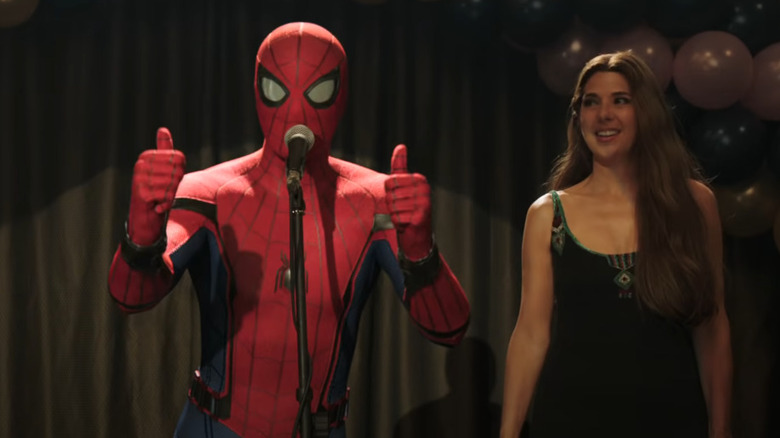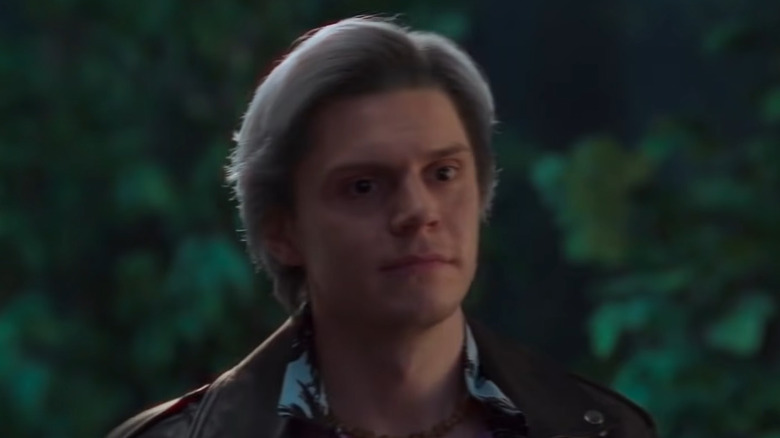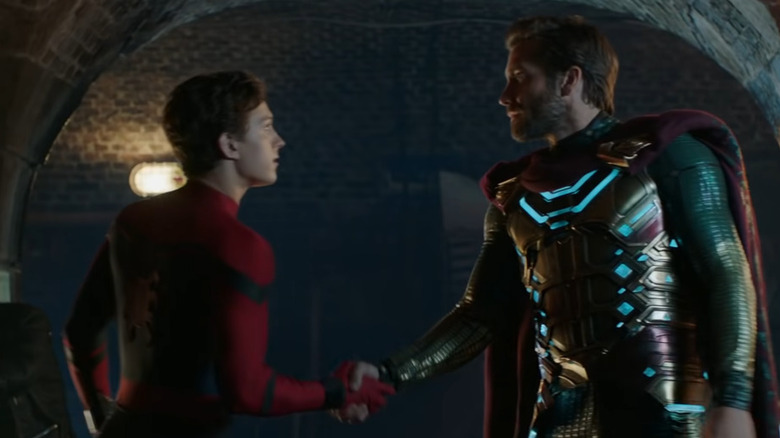The MCU's Biggest Red Herrings
Despite its tremendous success and enormous global fanbase, the Marvel Cinematic Universe has not been spared from criticisms. Chief among these is the observation that they're formulaic, and that regardless of character or setting, all the MCU films follow the Marvel brand, to their detriment. The AV Club captured the gist of this argument, in an article that questioned its truthfulness: "Despite whatever personal conflict or witty dialogue exchange occupies our heroes in the first two acts, they'll undoubtedly be battling it out with a giant CGI baddie in the final twenty minutes."
Even so, it's unfair to say that one can anticipate or predict everything that happens in a Marvel movie — especially since the studio seems particularly fond of misdirection, whether to create a more compelling story or to prevent its marketing efforts from spoiling any surprises before they even hit the silver screen. Here are some of the MCU's biggest red herrings.
The Mandarin in Iron Man 3 was just a fake
In the comics, the Mandarin is one of Iron Man's most formidable enemies. He's also among the most problematic, given how his earliest appearances had him looking and acting like an racist Asian stereotype (or as CBR puts it, a "Yellow Peril" villain). Attempts to modernize the villain, such as the '90s Iron Man animated series and 2010's "Invincible Iron Man Annual" #1, did away with his offensive roots, contributing to his continued popularity as Iron Man's arch-enemy.
Perhaps that's why the initial backlash was so intense when a dead ringer for Iron Man's foe appeared in "Iron Man 3." Trailers and even a LEGO set seemingly promised that the armored Avenger and the mystical ring-wielder would finally clash, ending the "Iron Man" film trilogy on an epic note. However, it all turned out to be a trick: this Mandarin was merely a hired actor named Trevor Slattery, a smokescreen to hide the identity of Tony Stark's true foe in "Iron Man 3."
Shockingly, the Marvel exclusive Blu-ray one-shot "All Hail the King" reveals another twist: A real Mandarin exists in the MCU — Shang-Chi's father — and he finds no flattery in this deception by Slattery. However, 2021's "Shang-Chi and the Legend of the Ten Rings" shows Slattery alive and well, evading execution by essentially becoming the Mandarin's jester and aiding Shang-Chi and Katy in their quest.
The marketing for Captain America: The Winter Soldier hid its true plot
Up until the film's actual release, fans thought that "Captain America: The Winter Soldier" would revolve mostly around Steve Rogers' best friend, as the title promised. As it turned out, the marketing campaign was carefully designed to hide the movie's most important secret — while dangling clues in plain sight.
The trailers made it seem like the Winter Soldier (a.k.a. Bucky) was the primary antagonist, with many clips pitting him against Steve (and even catching the Captain's shield effortlessly using his metal arm). However, it eventually becomes clear that the Winter Soldier was just a pawn in a greater scheme, a weapon utilized by Hydra infiltrators within S.H.I.E.L.D.'s ranks. The film ends with the global intelligence agency exposed for what it truly is, dynamically changing the landscape of the MCU.
However, there was one scene from a half-minute TV spot that caught the attention of many fans, according to Hollywood Reporter. Based on Steve's dialogue in the sequence, many anticipated that the film would include the death of S.H.I.E.L.D. director Nick Fury. Still, it doesn't seem like anyone accurately guessed the massive twist about the agency's true colors — and how that was connected to Fury faking his death not once, but twice in the film.
The Guardians of the Galaxy trailer's misleading line-up shot
The first trailer for James Gunn's "Guardians of the Galaxy" gave fans a better idea of what to expect from the rather oddball film. Until this point, the MCU movies had featured heroes who were fairly popular with the general public, due to their previous animated appearances or status as Avengers. The Guardians, on the other hand, were a relatively obscure team, which is perhaps why the lighthearted, humorous tone worked so well for it. This trailer also included a scene that accomplished two important things: It provided a glimpse of the entire team, while misleading fans about the actual timeline of their formation.
Near the end of the trailer, the movie's roster — Gamora, Star-Lord, Rocket, Groot, and Drax — are shown standing side by side in a police lineup, implying that they would get apprehended by authorities (in this case, the Nova Corps) after they start working together. However, the film actually has the final lineup forming during their time together in prison; they don't even become a properly functioning team until some time after their escape from the facility.
J.A.R.V.I.S. didn't really die in Avengers: Age of Ultron
In the comics, Edwin Jarvis is the Avengers' longtime butler. The MCU tweaks the timeline a bit by making him Howard Stark's butler instead. However, when Howard's son Tony designs the artificial intelligence system that would later help him operate his Iron Man suits, he comes up with a name that aptly pays tribute to his father's former manservant: Just A Rather Very Intelligent System, or J.A.R.V.I.S. for short. The AI system seemingly met its demise early on in "Avengers: Age of Ultron," in a face-off against the titular villain. But in a surprising twist, it became the AI component of Vision, the powerful synthezoid who became the key to defeating Ultron.
What's even more interesting is J.A.R.V.I.S./Vision actor Paul Bettany's revelation that he knew what would happen to J.A.R.V.I.S. well in advance: it was director Joss Whedon's idea to have Bettany become the Infinity Stone-powered superhero in the "Avengers" sequel. The home video release of "Avengers: Age of Ultron" includes a behind-the-scenes featurette that reveals how the team conceptualized the Vision, and that Whedon himself admitted that Bettany's transition from AI assistant to superhero was always part of the plan.
Groot dies heroically in Guardians of the Galaxy - or does he?
Near the end of "Guardians of the Galaxy," the film tugs at audiences' heartstrings with an unexpected death that cements the team's strong bond. In an attempt to protect his newfound family from certain death as Ronan the Accuser's ship crashes, the tree-like alien called Groot forms a defensive shell that shields his teammates from the impact, at the cost of his own life. However, hope springs anew at the end, as Baby Groot emerges from what was left of the towering Guardian. Given how comic book Groot has regeneration as one of his powers, this wasn't entirely surprising to fans familiar with the comics (via Hollywood Reporter).
However, while it's fair to say that this storytelling decision may have neutered the impact of Groot's death for some, it wasn't quite the resurrection that it seemed to be. In a 2017 Facebook post, Gunn clarified that the original Groot died, and that Baby Groot is really his offspring: "Although I don't necessarily think it's obvious in 'Vol. 1,' it's important to say that if you exploded and a little glob of you started growing into a baby, I would not assume that baby was you. I do think it's more obvious in 'Vol. 2,' as Baby Groot has a different personality than Groot, none of his memories, and is much, much dumber."
A guest Avenger was absent from Ant-Man trailers
Aside from humor and heist hijinks, "Ant-Man" also featured an unexpected treat for MCU fans. Sent on a mission to infiltrate the newly established Avengers training facility, the fledgling superhero comes face to face with Captain America's high-flying partner, the Falcon. In a quick sparring match, both heroes are able to demonstrate their abilities, with Ant-Man emerging as the victor. Interestingly, trailers for "Ant-Man" went the extra mile just to keep this sequence a surprise.
In a teaser for the film, Ant-Man is shown literally standing on the Avengers facility's lawn (which looks generic enough to pass as a random grassy area), but with the villainous Yellowjacket facing off against him in Falcon's place. This was obviously to hide the fact that Anthony Mackie would reprise his role in the film. Still, it's fascinating that the filmmakers decided to take this deliberately misleading route instead of just choosing a different scene to tease.
Spider-Man: Homecoming was marketed to look like a team-up movie
Spider-Man's long-anticipated entry into the MCU wasn't in a self-titled film, but in "Captain America: Civil War." Recruited by Iron Man to help him apprehend Captain America and his team of renegade heroes, Peter Parker gravitates towards Tony Stark, eventually forming a strong mentor-mentee relationship with his newfound father figure. This was further reinforced by the first trailer for "Spider-Man: Homecoming," which ended with a shot of the armor-clad hero and the webslinger rushing into action together. This created the impression that Spider-Man's first solo MCU movie would be a team-up film (via Sky News).
However, that particular shot ended up being excluded from the final cut of the film. As director Jon Watts explained in a ScreenCrush interview: "I think what happened was in the very first trailer they wanted a shot of Spider-Man and Iron Man flying together. And they were going to use something from the Staten Island Ferry [scene], but it just didn't look that great — the background plate, because the Staten Island terminal is a very simple building. So I think I was like, 'Let's just put them in Queens. Let's use that as a backdrop.' Because we couldn't just create a whole new shot, so let's just use one of these shots of the subway; put them in there."
The Hulk was fighting in Wakanda in Avengers: Infinity War trailers
Imagine this scenario: You're in charge of creating marketing materials for "Avengers: Infinity War," one of the most highly anticipated films in the MCU. Thing is, the film is so full of twists and surprises that by just including the wrong scene, you could potentially spoil major story developments. Pretty tough position, right? As it turns out, the team figured out a simple solution: Craft and edit scenes purely for the trailers, and design some of them in a way that deliberately misleads the audience.
One of the most noteworthy examples of this was the shot of the Hulk charging into battle with a team of superheroes and Wakandan soldiers. This hinted that there would be a massive fight scene that Bruce Banner's green-skinned alter ego would participate in. However, the finished product showed things going down differently: It would be Banner himself, incapable of transforming into the Hulk, who ended up joining the fight while piloting Iron Man's Hulkbuster armor. Directors Joe and Anthony Russo confirmed that this was a deliberate choice to give Banner, not the Hulk, "a chance to be the hero" for a change (via ComicBook.com).
Spider-Man: Homecoming trailers hid the movie's best twist
The title of Spider-Man's first solo foray into the MCU can be interpreted in at least two ways. It's a homecoming of sorts for the webslinger, whose cinematic rights were previously held exclusively by Sony Pictures. It's also a reference to the homecoming dance at Midtown High, where Peter Parker takes his crush Liz Allan for a date. The trailer for the film showed part of this sequence to tease romance for the young superhero — and it also helped to hide the movie's most shocking surprise.
The shot of Liz dancing with Peter and moving in for a kiss never appears in the final cut of "Spider-Man: Homecoming," as the superhero doesn't even get to stay at the party for long. In the movie, Peter has an extremely tense "heart-to-heart" conversation with Liz's father, revealed to be none other than Adrian Toomes, a.k.a. the Vulture. The two enemies discovered each other's secret identities en route to the dance, with Liz completely oblivious to the situation. Peter ultimately chooses responsibility over romance, and immediately leaves the venue to pursue the Vulture.
Laura Harrier, who played Liz, shared in an interview with ComicBook.com that they shot different kissing scenes that didn't make the cut. While this alone isn't confirmation of intentional misdirection, it's not a stretch — especially since the team did shoot a lot of other "meant-for-trailers-only" scenes.
The Skrulls in Captain Marvel were actually the good guys
When the Skrulls were first confirmed to appear in "Captain Marvel," fans understandably thought that they would be the film's main antagonists. After all, they've had a long history in the comics of being intergalactic invaders who often butted heads with Marvel's Earth-bound heroes. The trailers leaned heavily on this fact, creating an air of distrust and deception around the aliens (especially in the infamous train scene where Carol Danvers punches a Skrull disguised as an elderly woman in the face). However, audiences were thrown for a loop when they saw the final cut: A rival alien race, the Kree, were the true bad guys, and the Skrulls that made it to Earth were simply refugees looking for a new home.
In the Blu-ray release of "Captain Marvel," director Anna Boden shares the reasoning behind the twist: "[I]t's like these pointy-eared, weird looking shape-shifting aliens that we assumed were the villains for the first half of the film open up our hearts[...] that was one of the really exciting things about this movie for us: Taking these Skrulls, who are the villains from the comics, and being able to see another side of them, and then her reckoning with warring with these people who she didn't understand and was fighting on the wrong side of the war" (via The Credits).
Spider-Man: Far From Home trailers showed Spider-Man in his old suit
How exactly do you promote a movie whose lead character just died in an earlier film — without spoiling anything that could ruin the emotional impact of the latter? This was the challenge that the marketing team for "Spider-Man: Far From Home" had to deal with.
For a brief period of time before the film came out, Spider-Man was still technically dead. He was among the characters who got finger-snapped out of existence by Thanos in "Avengers: Infinity War." This obviously wasn't meant to last, given Spider-Man's profitability and popularity; still, the filmmakers had to maintain that air of secrecy and despair, at least until "Avengers: Endgame" could come out and reveal exactly how Spidey would return. Thus, when Marvel released the first teaser for "Far From Home" in January 2019, it showed Spider-Man wearing the same tech suit that he wore for most of "Homecoming."
As VFX Supervisor Julian Foddy explained in an interview with ComicBook.com: "[I] think prior to the release of 'Endgame,' the timeline of whereabouts in the whole timeline 'Far From Home' sat was ambiguous, so it was a conscious decision not to give that away as a reveal that he survives and makes it back to earth and has the Iron Spider suit in his possession.
A Fox X-Men actor's WandaVision casting hinted at multiverse shenanigans
When the fifth episode of "WandaVision" aired on Disney+, its ending caught many viewers completely by surprise. As part of Wanda's progressively worsening grip on reality, she unknowingly brings back her deceased brother Pietro, but with a twist: it wasn't Aaron Taylor-Johnson (who played the role in "Avengers: Age of Ultron") who showed up at her doorstep, but Evan Peters, the Quicksilver from the X-Men films released by 20th Century Fox. This fueled intense speculation that Wanda's powers managed to breach the multiversal barriers, and that Foxverse Quicksilver's appearance opened the gates for the X-Men to make their MCU debut at last.
However, this was ultimately revealed to be a fake-out: This Pietro wasn't even Pietro, but an ordinary citizen named Ralph Bohner who simply got dragged into Wanda's magical mess. "WandaVision" showrunner Jac Schaeffer told ScreenRant that this version of Quicksilver was always meant to be a mere puppet of the villainous Agatha Harkness. After this led to many fans feeling disappointed and betrayed, "WandaVision" director Matt Shakman (via ET) asked them to be patient and assured them that the Marvel multiverse is indeed in the works. At the very least, Marvel Studios showed how far they're willing to go for a Bohner joke.
Mysterio's multiverse story was a lie in Spider-Man: Far From Home
For anyone with even a smidgen of familiarity with the comic book version of Mysterio, the big twist in "Spider-Man: Far From Home" wasn't really that surprising. Still, it was an example of Marvel sticking to their guns and leaning heavily into a red herring in its promotional materials — one that they knew fans would want to be real.
The trailers for "Spider-Man: Far From Home" had Peter Parker meeting Mysterio a.k.a. Quentin Beck, a man who claims to be a hero from an alternate Earth. According to Beck, when Thanos was defeated in "Avengers: Endgame," the barriers of the multiverse cracked, enabling monstrous threats called Elementals to escape from his world into Peter's.
Of course, this all turned out to be a lie: Beck was actually a former Stark Industries employee with an axe to grind against his late ex-boss. In a plot to dominate the world, Beck and his other angry workmates developed illusion technology to fashion himself into a superhero who could step in to fill the gap that the deceased and retired Avengers had left. He simply came up with the multiverse story to fool Peter and Nick Fury (who, in another twist, was revealed to be a Skrull filling in while the real one was taking a vacation).
